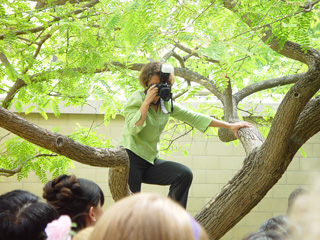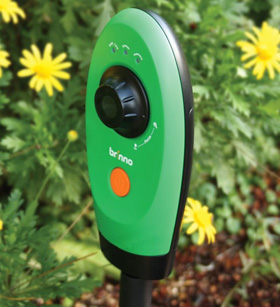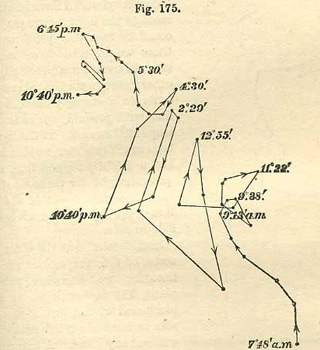Human Flower Project
One for the Plant Paparazzi
Pumpkin growing, dandelion seed-scattering, and other activities of the plant world cry out for moving images. The EarthScholars tip us off to an advance in time-lapse photography.

Shooting a bloom: a green paparazzo at work
Photo: Turbophoto
By James H. Wandersee and Renee M. Clary
EarthScholars™ Research Group
There are throngs of freelance photographers lurking out there, hoping to catch celebrities in the act of everyday living. You can now be part of a photographic venture that’s equally as exciting – maybe more so. Who wants to join the plant paparazzi?
Want to record your four o’clock flowers opening in mid-afternoon and closing in early morning? Want to watch bumble bees visiting your snapdragons? How about capturing the blooming and seed dispersal of dandelions? Or shooting an apple tree from blossom-time to ripe fruit? Or showing everyone how you raised a giant pumpkin?
There are lots of reasons to take outdoor time-lapse movies, and lots of ways to do so. But until now, most of them have required photo-technical expertise, multiple pieces of delicate equipment, tripods, electrical cords, and protection from the elements.

Pseudo time-lapse image series: Flowering hyacinth (the favorite flower of Madame de Pompadour)
Photo: Flower Gardening Made Easy
Voilà! We are happy to report that now you can track plant growth and movement in your own environs via the new, simple, easy-to-use, Brinno digital video GardenWatchCam. Simply choose your preferred camera settings, attach this little green camera to its mounting stake, insert the adjustable stake into the soil in the vicinity of your plant subject(s), and, at the touch of a single button, the camera will proceed to make a plant movie for you. It has a light sensor that turns off the camera at dusk and back on again at dawn, allowing for continued video capture during daylight hours each day.
This camera’s weatherproof exterior enables it to function between 122° F and 14° F. It takes up to 18,000 snapshots (JPEG images) of your plants at adjustable, pre-set time intervals, and will also automatically combine the individual images into a single 1,280 x 1,024 pixel AVI digital format video, a “movie” that you can watch immediately on a Windows or Mac computer or on any AVI video player, or burn to a DVD.
 The Brinno GardenWatchCam
The Brinno GardenWatchCam
Photo: Brinno
Four penlight batteries (type AA) power the camera for shooting periods of up to 4 months (if you set the camera for one photo per hour). In case you want to use editing software to spruce-up your movies, each movie is time-stamped and stored on the camera’s removable 2GB USB flash drive—for plug-and-play convenience.
You can photograph individual plant specimens or entire garden areas: the camera’s lens can focus as close as 18 inches away to illustrate floral development or, with its wide-angle 54° field of view, it can capture an entire flower bed or water garden. You can set it for either “close-up” or “distance” focus. It also tilts on its base so you can aim it up or down.
The 1.3 megapixel camera takes a picture at one of seven time intervals that you select – from once every 5 seconds to once every 24 hours. The Brinno “Easy Photo” software disk is also included. You decide how fast your camera needs to take photos, depending upon whether you estimate the natural progression you are shooting will take minutes, hours, days, weeks, or months to complete. A standard tripod socket is also provided for quick projects.
How much does it cost? You can shop online to find the best price from suppliers, but, as an example, Amazon.com currently charges $139.95— roughly the cost of a typical point-and-shoot digital camera. The Brinno GardenWatchCam measures 7 1/2” H x 3 1/2” W x 2” D and weighs just 12 oz.—so it’s very unobtrusive. Just don’t expect National Geographic image quality!
Given that you may simply leave the camera set-up outdoors for long periods of time, we think its being small, its mounting low to the ground, and its foliage-green-and-black color combine to make it considerably less noticeable to potential thieves than many other time-lapse camera set-ups we’ve seen—including hunters’ trail cameras.
It is even possible to display your movies online for your friends and/or the whole world if you decide to upload them to a video-sharing site such as YouTube.com. Plant time-lapse movies can be quite breath-taking! See, for example, this 10-day-long movie of a geranium blooming that has attracted thousands of viewers.
 One of the Darwins’ diagrams of plant phototropism (pre-digital video)
One of the Darwins’ diagrams of plant phototropism (pre-digital video)
Image: Science Musings
Time-lapse digital-video garden cameras will no doubt evolve and improve over time. Whether you decide to try using this particular device or something else to make time-lapse digital movies of flora, we invite you to investigate (via your camera lens) “The Power of Movement in Plants.”
By the way, that’s the actual title of an 1880 book published by biologist Charles Darwin and his son, Sir Francis, reporting on their observational studies of plant phototropism. This book is available at no cost for your reading pleasure. Oh, how those two would have loved using these digital cameras in their own botanical investigations!
Comments
I know what you mean, Russ, except that Jim and Renee are reliable scholars, and know about research ethics, internal review boards, etc.
I AM, though, gathering more info from Jim about how they discovered this product.
By the way, I’ve never come across this device, and posting this article is not intended as an endorsement.
Thanks for your critical eye,
J.
We have been experimenting with the time-lapse imaging of plants for many years and have used lots of imaging products, including such devices as a film camera triggered by an intervalometer, and a tethered digital camera connected to a laptop computer. These had to be enclosed in special shelters to protect them from the elements. Our more recent work has used the tiny, weather-proof, Pentax Optio W60 digital camera which has a built-in time-lapse program and is sold with accompanying ACDsee software on CD-ROM. However, the Brinno camera that we mentioned in this article is our latest tool, and it is the only one we know of at this writing that: (a) is designed specifically for outdoor plant imaging; (b) is simple enough to use without a steep learning curve; (c) that self-compiles its images into a runnable movie without requiring post-imaging skills and processing on a computer; and (d) that has a modest price-point. We wanted to provide as much technical information as possible for HFP readers to decide if such a simple device would be of use to them, and we also caution them about image quality issues. Towards the end of our article, we encourage HFP readers to experiment with time-lapse imaging, and we affirm that many commercial imaging solutions and sources are available to them. We also point out that plant imaging options will continue to evolve and appear in the consumer marketplace. We have no ties to any of the companies that make time-lapse imaging equipment and the specifications that we included were intended to provide the technical information that we would want to know if we were reading this article. Our hope was to present the idea that plants move and change—but on a different time scale, one that is hard for people to perceive without a tool such as this, a tool that is now less daunting and expensive to use than in the past.
An economical gift for a plant lover!
Once I photographed the progress of a paper white (I think it was a paper white) blossoming. Winters in the northeast can be dreary.


This sounds suspiciously like an advert…..